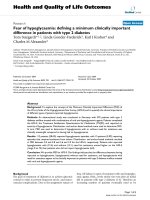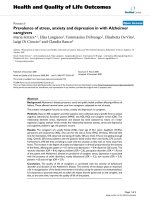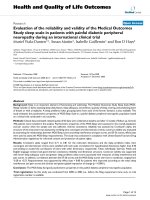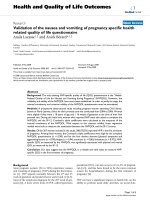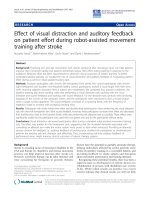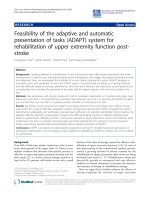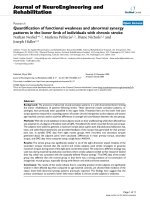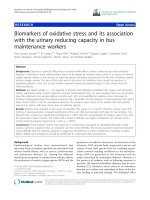Báo cáo hóa học: " Bioconjugates of Glucose Oxidase and Gold Nanorods Based on Electrostatic Interaction with Enhanced Thermostability" ppt
Bạn đang xem bản rút gọn của tài liệu. Xem và tải ngay bản đầy đủ của tài liệu tại đây (330 KB, 5 trang )
NANO EXPRESS
Bioconjugates of Glucose Oxidase and Gold Nanorods Based
on Electrostatic Interaction with Enhanced Thermostability
Zhanfang Ma Æ Teng Ding
Received: 20 May 2009 / Accepted: 1 July 2009 / Published online: 15 July 2009
Ó to the authors 2009
Abstract Bioconjugates made up of an enzyme and gold
nanorods (GNRs) were fabricated by electrostatic interac-
tions (layer-by-layer method, LBL) between anionic glucose
oxidase (GOD) and positively charged GNRs. The assem-
bled processes were monitored by UV–Vis spectra, zeta
potential measurements, and transmission electron micros-
copy. The enzyme activity assays of the obtained bioconju-
gates display a relatively enhanced thermostability behavior
in contrast with that of free enzyme. Free GOD in solution
only retains about 22% of its relative activity at 90 °C.
Unexpectedly, the immobilized GOD on GNRs still retains
about 39.3% activity after the same treatment. This work will
be of significance for the biologic enhancement using other
kinds of anisotropic nanostructure and suggests a new way of
enhancing enzyme thermostability using anisotropic metal
nanomaterials.
Keywords Gold nanorods Á Enzyme thermostability Á
Glucose oxidase Á Polyelectrolytes
Introduction
Considerable effort has been devoted to the study of gold
nanoparticles with variable size and shape due to their
unique geometry-dependent optical, electronic, and cata-
lytic properties in electronics and optics [1–5], particularly
in the fields of biotechnology and nanotechnology [6–8].
Recently, gold nanorods (GNRs) have attracted interest due
to their unusual properties in electronics and optics [9, 10]
and especially in bionanotechnology fields involving bioi-
maging [11, 12], biosensing [13–16], DNA expression [17],
cancer therapy [18], etc. For GNRs, two distinct plasmon
bands, a transverse mode (*520 nm) and a longitudinal
mode (usually [600 nm), can be observed. This unique
optical property of GNRs opens up fascinating applications
as biologic and chemical sensors. A versatile layer-by-layer
approach to the preparation of polyelectrolyte-coated GNRs
films has been reported [19, 20], indicating that polyelec-
trolytes are effective coating reagents for the modification
of GNRs.
The immobilization of an enzyme is one of the crucial
factors in a range of biologic techniques. Proteins have
traditionally been immobilized on to solid surfaces by a
variety of techniques including physical adsorption, solvent
casting, covalent binding, and electropolymerization [21].
Although enzymes have been immobilized on to the sur-
face of polystyrene latex [22], gold nanoparticles (GNPs),
or silica nanoparticles [23–25], there are few reports in
which anisotropic nanoparticles have been used to conju-
gate the enzyme. In this work, GNRs were used to prepare
a bioconjugate with an enzyme, using GOD as a model
enzyme. The thermostability of the GNR/GOD bioconju-
gates was dramatically enhanced, and even at 90 °C, its
relative activity still remained at about 39.3%.
Experimental Section
Materials and reagents. GOD (EC 1.1.3.4, 211 U mg
-1
from Aspergillus niger) and peroxidase from horseradish
(HRP, 969.65 U mg
-1
) were purchased from Fluka. D-(?)-
glucose (99%), Chloroauric acid (HAuCl
4
Á3H
2
O, 99.9%),
L-(?)-Ascorbic acid (AA, 99?%), Silver nitrate (AgNO
3
,
99.9%), and Cetyltrimethylammonium bromide (CTAB,
Z. Ma (&) Á T. Ding
Department of Chemistry, Capital Normal University,
100048 Beijing, People’s Republic of China
e-mail:
123
Nanoscale Res Lett (2009) 4:1236–1240
DOI 10.1007/s11671-009-9385-8
98%) were purchased from Alfa-Aesar. o-Dianisidine
and Sodium borohydride (NaBH
4
,98?%) were obtained
from Sigma (USA). The polyelectrolytes, poly (sodium-4-
styrenesulfonate) (PSS, Mw *70,000 g/mol), and poly
(diallyldimethylammoniumchloride) (PDADMAC, Mw ca.
200,000–350,000 g/mol) were obtained from Aldrich and
used without further purification. All chemicals were used
as received.
Synthesis of GNRs. GNRs were prepared according to
the seed-mediated growth method. Briefly, a seed solution
was prepared by mixing 5 mL of CTAB (0.2 M) and 5 mL
of HAuCl
4
(0.5 mM) with 0.6 mL freshly prepared 10 mM
ice-cold NaBH
4
solution. The color of the solution changed
from dark yellow to brownish yellow under vigorous stir-
ring, indicating the formation of the seed solution. After
5 h, this seed solution was used for the synthesis of the
GNRs. In a flask, 75 mL of 0.2 M CTAB was mixed with
1.5 mL of 4 mM silver nitrate aqueous solution and 75 mL
of 1 mM HAuCl
4
. After gentle mixing of the solution,
1.05 mL 0.10 M AA was added. While continuously stir-
ring this mixture, 180 lL of the seed solution was added to
initiate the growth of the GNRs. These GNRs were aged
for 24 h to insure full growth.
Polyelectrolyte Coating of GNRs. About 10 mL of as-
prepared GNRs was centrifuged twice at 8,000 rpm for
10 min, the supernatant was discarded, and the precipitate
was redispersed in 5 mL 1 mM CTAB. Subsequently, it
was added dropwise to 5 mL of PSS (2 g L
-1
, 1 mM NaCl)
aqueous solution. After 1 h adsorption time, it was centri-
fuged twice at 8,000 rpm to remove excess polyelectrolyte
and dispersed in 5 mL deionized water. Finally, the PSS-
coated GNRs were added dropwise to 5 mL of PDADMAC
(2 g L
-1
, 1 mM NaCl) aqueous solution. After 1 h, it was
centrifuged twice at 8,000 rpm to remove excess poly-
electrolyte and dispersed in 5 mL of phosphate buffer
solution (10 mM, pH 7.0).
Preparation of GOD/GNRs Bioconjugates. The combi-
nation of GOD and GNRs was achieved using electrostatic
interaction. In detail, the above 1.5 mL cationic PDAD-
MAC-coated GNRs was centrifuged at 8,000 rpm for
10 min, the supernatant was discarded, and the precipitate
was incubated with 1.5 mL GOD (1 mg mL
-1
) dissolved
in phosphate buffer (10 mM, pH 7.0) for about 1 h at
30 °C. The resultant mixture was centrifuged to discard
free GOD and washed by phosphate buffer containing
Tween 20. The target GOD/GNR bioconjugates were
finally dispersed under ultrasonication in 1.5 mL phosphate
buffer solution (10 mM, pH 7.0) and stored at 4 °C.
Enzyme relative activity assays. The activities of free
GOD at different temperatures were monitored using
UV–Vis spectroscopy at k = 460 nm based on the change
in solution color, which results from the oxidation of
o-dianisidine by the reaction product hydrogen peroxide
from glucose in the presence of HRP. The chemical
equations are as follows.
b-D-glucose + O
2
+H
2
O
!
Glucose oxidase
D-gluconic acid + H
2
O
2
H
2
O
2
þ o-dianisidine(reduced)
!
peroxidase
o-dianisidine(oxidized) + H
2
O:
Typically, 2.5 mL of a 0.33 mM o-dianisidine solution
in 0.1 M buffer, 0.3 mL 5 g L
-1
glucose solution, and
0.1 mL 0.02% HRP were mixed as substrate. Then, 10 lL
of the free GOD solution (1 mg mL
-1
) was added into the
mixture, and the absorption of the mixture was recorded
immediately and for the next 4 min. For the GOD/GNR
system, the measuring procedures were the same as those
for free GOD in solution except for the use of 10 lL
GNRs@PSS@PDADMAC@GOD (GOD/GNRs bioconju-
gates) and 10 lL GNRs@PSS@PDADMAC instead of
10 lL of free GOD, respectively.
Control experiment. 1 mL PDADMAC (2 g L
-1
,1mM
NaCl) aqueous solution was mixed with 1 mL GOD
(2 mg mL
-1
) in a phosphate buffer (10 mM, pH 7.0) for
about 1 h at 30 °C. The resulting concentration of GOD in
the PDADMAC/GOD bioconjugates is 1 mg mL
-1
. Then,
an enzyme activity assay was performed.
Apparatus and measurements. UV–Vis absorption
spectra were obtained using a UV-2550 spectrophotometer
with temperature controller (S-1700, Shimadzu, Japan).
Zeta potentials and size distributions were measured on a
Zetasizer nano 90 and Zetasizer 3000HSA (Malvern,
England), respectively. TEM was performed with a JEOL-
JEM-1011 electron microscope under 100 kV accelerating
voltage. Formvar-coated copper grids (200 meshes) were
used as the support carrier.
Results and Discussion
It is well known that a protein can be regarded as an anionic
or cationic polyelectrolyte by simply adjusting the pH value
of the protein solution to be higher or lower than its iso-
electric point (pI). The formation of a protein–polyelec-
trolyte complex at pH [pI with polycations and at pH \ pI
with polyanions can be easily achieved. The bioconjugates
of GOD and GNRs were fabricated using the electrostatic
interaction between GOD and cationic polyelectrolyte-
coated GNRs, as shown in Scheme 1. The GNRs used in
this study were prepared by the seed-mediated growth
method in cetyltrimethylammonium bromide (CTAB) sur-
factant solution [26] and were positively charged due to the
Nanoscale Res Lett (2009) 4:1236–1240 1237
123
coating of the CTAB bilayer. Because the free CTAB and
the fixed CTAB on the substrate possess high cytotoxicity
and cause denaturation of proteins [27, 28], the as-prepared
CTAB-coated GNRs were treated with anionic poly
(sodium-4-styrenesulfonate) (PSS), resulting in negatively
charged PSS coatings on the GNRs. Subsequently, posi-
tively charged poly(diallyldimethylammoniumchloride)
(PDADMAC) was absorbed on to them. In this case,
anionic GOD in the phosphate buffer solution (10 mM, pH
7.0), in which the pI of GOD is 4.2, can easily be attached
electrostatically on to the PDADMAC-coated GNRs,
resulting in the formation of bioconjugates of GOD and
GNRs. The resultant GOD/GNR bioconjugates display
dramatically enhanced thermostability, much better than
that of the free enzyme and even better than the reported
results for GOD immobilized on planar substrates, poly-
styrene nanoparticles, and spherical gold nanoparticles.
Gold nanorods exhibit transverse surface plasmon res-
onance (TSPR) as well as longitudinal surface plasmon
resonance (LSPR) bands. The UV–Vis spectra of the GNRs
with different coatings are shown in Fig. 1A. For the as-
prepared GNRs, there is a TSPR peak at about 520 nm and
a LSPR peak at 691 nm (Fig. 1A, curve a). Compared with
the LSPR peak of the as-prepared GNRs, there are red
shifts for the GNRs with a PSS coating (697 nm, curve b)
and with a PDADMAC coating (703 nm, curve c), showing
that the polyelectrolytes are successfully adsorbed on to the
GNRs via electrostatic interactions. After GOD (pH 7.0)
solutions were added to the PDADMA-coated GNR sus-
pension, the LSPR peak located at 723 nm was observed,
as shown in Fig. 1A curve d. Compared with that of
PDADMAC-coated GNRs, there is a red shift of about
20 nm indicating that the GOD has been electrostatically
absorbed on to the GNRs.
Zeta potentials (f) were measured to follow the forma-
tion of the GOD/GNR bioconjugates. The f-potential of the
coated GNRs was measured after deposition of each layer,
as shown in Fig. 1B. The f-potential of the as-synthesized
GNRs is about ?33.2 mV due to the presence of a bilayer
of cationic CTAB on the surface of the GNRs. When the
negatively charged PSS and the positively charged
PDADMAC formed the outermost layer, negative and
positive f-potentials can be observed at -50.8 mV and
?50.6 mV, respectively. When anionic GOD is adsorbed
on to GNRs@PSS@PDADMAC, the f-potential is about
-15.4 mV. This is the qualitative evidence for the stepwise
Scheme 1 Schematic
illustration of the fabrication of
the GOD/GNR bioconjugates
Fig. 1 A UV–Vis spectra of CTAB-stabilized GNRs (curve a), GNRs/
PSS (curve b), GNRs@PSS@PDADMAC (curve c), and GNRs@
PSS@PDADMAC@GOD (curve d). B Zeta potentials of GNRs
coated with multilayers, CTAB (first layer), and those sequentially
coated with PSS (second layer), PDADMAC (third layer), and GOD
(fourth layer), respectively
1238 Nanoscale Res Lett (2009) 4:1236–1240
123
deposition of polyelectrolyte and GOD. Besides f-poten-
tials measurements, size distributions of GNRs, GNRs@
PSS@PDADMAC, and GNRs@PSS@PDADMAC@GOD
were also performed, which is consistent with f-potential
values (as shown in the supplementary material). The
aspect ratio of the used GNRs is about 2.7 ± 0.4, and the
thickness of the coating layer is about 5 nm, as shown in
Fig. 2. This provides further evidence that the GOD was
successfully adsorbed on to the GNRs.
The practical application of immobilized enzymes
depends on their stability under various conditions, e.g.,
temperature. In this case, the activity and thermostability of
GOD was examined for the GOD/GNRs. The optimum
catalytic activity for free GOD was observed at pH 7.0
[29], and the isoelectric point of GOD is 4.2. Cationic
PDADMAC-coated GNRs were, therefore, incubated with
GOD in phosphate buffer (10 mM, pH 7.0), in which the
GOD was negatively charged.
In order to address the influence of GNRs on the ther-
mostability of GOD, the free GOD in solution and GOD
immobilized on to the GNRs were exposed to a defined
temperature for 15 min, and the enzyme activity assays
[28] were immediately performed. In this work, the relative
activity is defined as follows. For the same concentration of
glucose, the UV–Vis absorbance of GOD/GNRs biocon-
jugates or free GOD at 460 nm, after the reaction with
glucose, are represented at different temperatures as A
i,460
,
except A
max
at 40 °C, which was regarded as 100%
activity. The relative activities of GOD at different tem-
peratures were obtained from the ratio A
i,460
/A
max
. In order
to eliminate the influence of the absorbance of GNRs on
the values of A
i,460
, the relative activities of the GOD
immobilized on GNRs were obtained from (A
i,460
-
AÁA
i,0,460
)/(A
max
- A
i,0,460
), where A
i,0,460
represents the
absorbance of GNRs@PSS@PDADMAC at 460 nm. In
order to make the relative activities of free GOD and the
GOD immobilized on GNRs comparable, the amount of
GOD used to prepare the GOD/GNRs was the same as that
of the free GOD used to measure the enzyme assays. Each
set of experiments was carried out in triplicate to confirm
the reproducibility of the system.
Figure 3 shows the relative activities versus temperature
for the GOD immobilized on GNRs (GOD/GNRs), free
GOD, and the GOD immobilized on PDADMAC (GOD/
PDADMAC). The maximum activities were reached at
around 30–40 °C for all of them. A similar increase in
activity can be seen in the range 20–30 °C. A sharp
reduction in activity with temperature is observed for all of
Fig. 2 TEM images of the
GNRs (A) and GOD/GNR
bioconjugates after stained by
uranyl acetate (B)
Fig. 3 Enzyme thermostability of (a) immobilized GOD (b) free
GOD, and (c) PDADMAC-blended GOD
Nanoscale Res Lett (2009) 4:1236–1240 1239
123
them at temperatures over 40 °C. Surprisingly, when the
temperature reached 90 °C, the relative activity of GOD/
GNRs remained at about 39.3%. This showed that there is a
relatively higher degree of thermostability for immobilized
GOD. The relative activities of the free GOD and
PDADMAC/GOD bioconjugates were only 22.0 and
15.4%, respectively, as shown in Fig. 3. This suggested
that it is the structure of enzyme assembly that has great
effects on enzyme activity.
Conclusion
In summary, we have demonstrated that GOD can be
successfully adsorbed on to polyelectrolyte-coated GNRs
via electrostatic interactions. According to enzymatic
catalysis examination, the GOD/GNRs bioconjugates have
extraordinary stability at high temperature in contrast not
only with the free enzyme in solution but also previously
reported GOD systems with other nanoparticles. Therefore,
GNRs can be expected to be a promising matrix for the
immobilization of other kinds of enzymes and proteins
with greatly enhanced stability for biosensor applications.
The present results will be of significance for the biologic
enhancement effects using other kinds of anisotropic
nanostructures. Although the mechanism by which GNRs
dramatically enhance the enzyme thermostability of GOD
is still an open question, with further experiments to
understand the detailed effect of GNRs on GOD being
pursued, the present work has already suggested a new way
of enhancing enzyme stability and will be of significance in
designing new kinds of enzyme-based nanoreactors for
biosensors and biocatalytic reactors using other kinds of
anisotropic nanostructures.
Acknowledgments This study was supported by Development
Program of Science and Technology of Beijing Municipal Education
Commission (KM200810028010) and Capital Normal University.
References
1. W.S. Lu, L. Lin, L. Jiang, Biosens. Bioelectron. 22, 1101 (2007)
2. C.J. Murphy, T. Sau, A. Gole, C. Orendorff, J. Gao, L.F. Gou,
S. Hunyadi, T. Li, J. Phys. Chem. B 109, 13857 (2005)
3. C.J. Murphy, A. Gole, S. Hunyadi, W. Stone, P.N. Sisco,
A. Alkiany, B.E. Kinard, P. Hankins, Chem. Commun. 5, 544
(2008)
4. D.X. Li, Q. He, Y. Cui, J.B. Li, Chem. Mater. 19, 412 (2007)
5. M.C. Daniel, D. Astruc, Chem. Rev. 104, 293 (2004)
6. S.X. Zhang, N. Wang, H.J. Yu, Y.M. Niu, C.Q. Sun, Bioelec-
trochemistry 67, 15 (2005)
7. T. Liu, J. Tang, L. Jiang, Biochem. Biophys. Res. Commun. 313,
3 (2004)
8. L. Pasquato, P. Pengo, P. Scrimin, J. Mater. Chem. 14, 3481
(2004)
9. X.H. Huang, I.H. El-Sayed, W. Qian, M.A. El-Sayed, J. Am.
Chem. Soc. 128, 2115 (2006)
10. H.K. Ding, T. Yong, I. Roy, J. Phys. Chem. C 111, 12552 (2007)
11. I.H. El-Sayed, X.H. Huang, M.A. El-Sayed, Nano Lett. 5, 829
(2005)
12. N.J. Durr, T. Larson, D.K. Smith, B.A. Korgel, K. Sokolov,
A. Ben-Yakar, Nano Lett. 7, 941 (2007)
13. C.G. Wang, Z.F. Ma, T.T. Wang, Z.M. Su, Adv. Funct. Mater.
16, 1673 (2006)
14. C.G. Wang, Y. Chen, T.T. Wang, Z.F. Ma, Z.M. Su, Chem.
Mater. 19, 5809 (2007)
15. C.G. Wang, Y. Chen, T.T. Wang, Z.F. Ma, Z.M. Su, Adv. Funct.
Mater. 18, 355 (2008)
16. C.X. Yu, J. Irudayaraj, Anal. Chem. 79, 572 (2007)
17. J.W. Stone, P.N. Sisco, E.C. Goldsmith, S.C. Baxter, C.J. Murphy,
Nano Lett. 7, 116 (2007)
18. L. Tong, Y. Zhao, T.B. Huff, M.N. Hansen, A. Wei, J.X. Cheng,
Adv. Mater. 19, 3136 (2007)
19. A. Gole, C.J. Murphy, Chem. Mater. 17, 1325 (2005)
20. X. Hu, W. Cheng, T. Wang, Y. Wang, E. Wang, S. Dong, J. Phys.
Chem. B 109, 19385 (2005)
21. Y. Lvov, H. Mo
¨
hwald (eds.), In protein architecture: interfacing
molecular assemblies and immobilization biotechnology (Marcel
Dekker, New York, 2000)
22. F. Caruso, C. Schu
¨
ler, Langmuir 16, 9595 (2000)
23. Z.J. Chen, X.M. Qu, F.Q. Tang, L. Jiang, Colloids Surf. B 7, 173
(1996)
24. Z.J. Chen, J.R. Li, X.C. Li, L. Jiang, Biochem. Biophys. Res.
Commun. 245, 352 (1998)
25. D.X. Li, Q. He, Y. Cui, L. Duan, J.B. Li, Biochem. Biophys. Res.
Commun. 355, 488 (2007)
26. B. Nikoobakht, M.A. El-Sayed, Chem. Mater. 15, 1957 (2003)
27. E.E. Connor, J. Mwamuka, A. Gole, C.J. Murphy, M.D. Wyatt,
Small 1, 325 (2005)
28. D. Mirska, K. Schirmer, S.S. Funari, A. Langner, B. Dobner,
G. Brezesinski, Colloids Surf. B 40, 51 (2005)
29. P. Pandey, S.P. Singh, S.K. Arya, Langmuir 23, 3333 (2007)
1240 Nanoscale Res Lett (2009) 4:1236–1240
123

